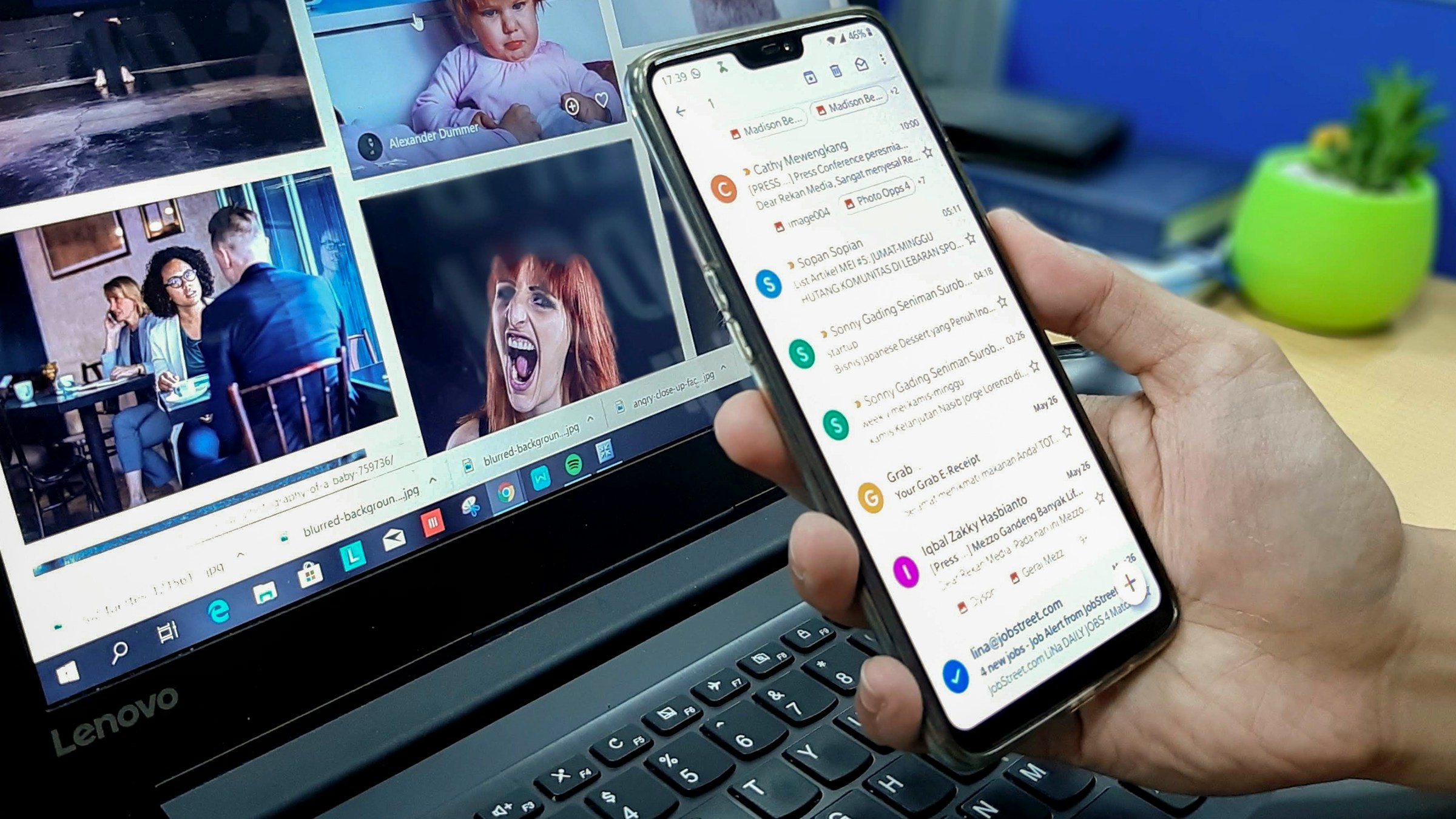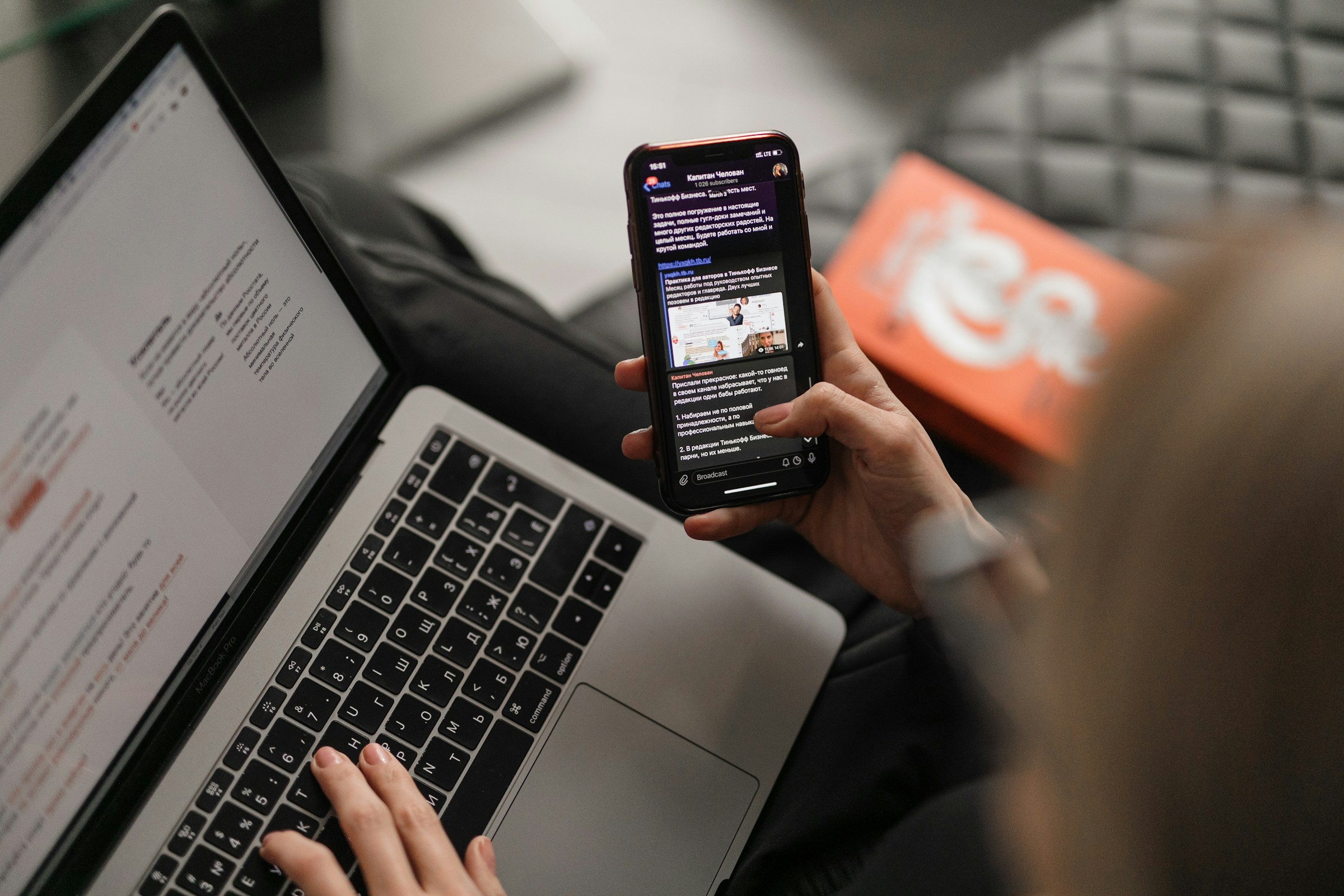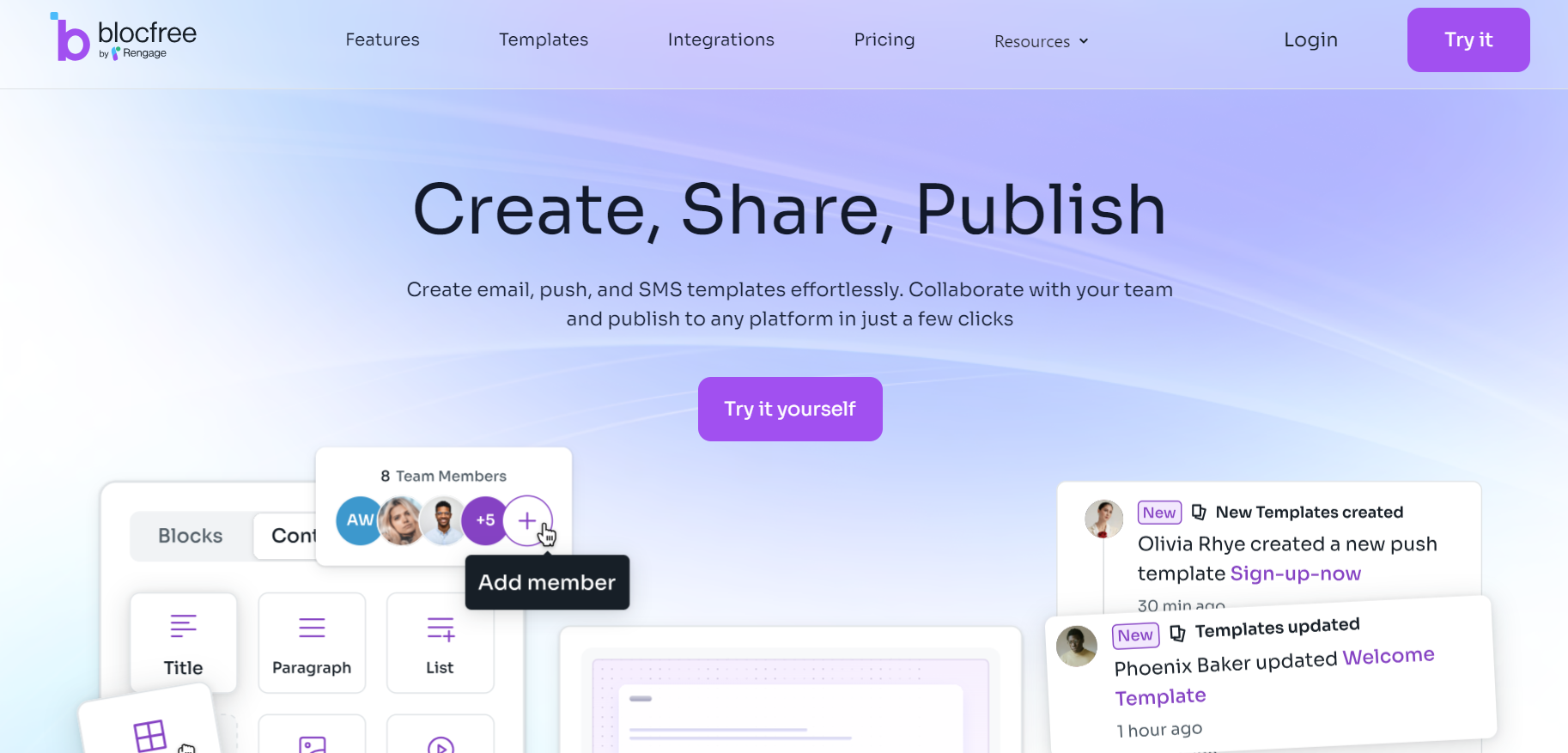13 Email Segmentation Strategies for Hyper-Targeted Campaigns
Picture this: You've sent out your latest email campaign for your small business, and while you're excited to see the results, you can't help but feel that something is off. You received a decent open rate, but the click-through rate needs to be higher. You know your emails could perform better, but you need help to achieve the desired results. If this sounds familiar, you should improve email deliverability and your email segmentation skills. Email segmentation is a critical strategy for creating personalized email campaigns that boost engagement and conversions. In this article, we'll explore the ins and outs of email segmentation, including its benefits for your business and how to get started.
One way to make email segmentation less daunting is to use an email template builder to personalize your email campaigns. At Blocfree, our template builder offers many tools and features to help you create highly customized email templates, making your email segmentation tasks easier and more efficient.
What is Email Segmentation?

Email segmentation, or list segmentation, involves breaking your email recipients into smaller, targeted groups and sending them the most relevant information. These smaller groups are usually based on behavioral or demographic data, maybe their state of residence, past purchases, or tasks they carried out on your site.
Tailored Content for Targeted Results
The segments can be as large (for example, people who bought a specific product through your Instagram shop) or as small (for example, Arizona residents who signed up for your newsletter less than a day ago) as you want. But the smaller they get, the more direct and targeted your content should be, and the more likely it will resonate with the recipients.
Killer Examples of Email Segmentation Strategies
Email segmentation is not a one-size-fits-all solution. Instead, it comes in various types, each focusing on distinct criteria that help you send better emails. Here are some examples of email segmentation strategies:
Demographic Segmentation
Demographic segmentation groups subscribers by traits like age and gender. This enables you to tailor emails to resonate with specific demographics (e.g., diapers for new parents vs. other paper products for non-parents).
Behavioral Segmentation
Behavioral segmentation groups subscribers based on their actions and interactions.) with your emails, texts, website, and more. This enables you to target your most active subscribers (e.g., those who have opened emails in the past 6 months) or those who are most likely to be interested in a given campaign (e.g., those who frequently click on a specific category of products).
Psychographic Segmentation
Psychographic segmentation groups subscribers based on their interests, values, lifestyles, and personalities. This enables you to target emails based on what people care about, not just who they are (such as emails about eco-friendly products to environmentally conscious subscribers).
Geographic Segmentation
Geographic segmentation groups subscribers by location. This enables you to send targeted emails about local events, promotions, or information relevant to someone’s region (such as emails about upcoming sales at a local store).
Lifecycle Stage Segmentation
Lifecycle stage segmentation involves categorizing subscribers based on their stages in the customer journey, such as new leads, active customers, or lapsed customers.
Email Segmentation Statistics to Know in 2024
Personalization and segmentation are essential and powerful to improve your email marketing ROI.
How Effective is Email Segmentation?
According to DMA, 25% of revenue share comes from a segmented list of emails, and sending targeted emails to these segments brings 30% of revenue. 15% of marketers need to segment their email list. So, if you are not segmenting and targeting these segments to send personalized emails, you are ignoring a lot of revenue.
Basic vs. Advanced Email Segmentation
Here are some stats showing businesses leveraging email segmentation at a basic and advanced level:
Just 31% of businesses use basic segmentation to send emails. One reason could be that the platforms used to send emails do not provide advanced segmentation options. When using email automation, only 13% of advanced segmentation was used to send emails, according to the GetResponse report.
Why Email Segmentation Is Important
Your subscribers are not the same, and one size cannot fit all, so it is important to cater to your customers' needs according to their interests and preferences. Here are some email segmentation statistics that will prove this:
According to Campaign Monitor, 74% of online consumers get frustrated when content like offers, ads, and promotions are not aligned with their interests. According to DMA, marketers have found a 760% increase in email revenue from segmented campaigns.
Related Reading
10 Benefits of Email Segmentation

1. Increased Relevance
Segmentation allows marketers to send highly relevant emails to subscribers based on their attributes or past behaviors. This relevance can lead to higher engagement rates as the content resonates more with the recipients. For instance, if a recipient downloads a guide to email marketing, they might appreciate a follow-up email that offers tips on improving email deliverability.
An email about improving email deliverability would feel particularly relevant to this subscriber and their current needs, rather than a generic email about improving email deliverability that could go to anyone.
2. Improved Open and Click-Through Rates
Segmented email campaigns have higher open and click-through rates than non-segmented campaigns. This is because the content is tailored to the interests and needs of the segment. Using the example above, it’s more likely that the recipient will open the email about improving email deliverability since it aligns with their current goals. As a result, they’ll also be more likely to engage with the content and follow any CTAs included in the email.
3. Better Conversion Rates
With more relevant content, recipients are more likely to take the desired action, whether:
- Purchasing
- Signing up for a webinar
- Following a call to action (CTA)
For example, let’s say you run an online store that sells bicycle parts. Suppose a customer purchases a mountain bike repair kit, and you send them an email with a coupon for mountain bike accessories. In that case, they’ll be much more likely to convert to this offer than a generic email about bicycle accessories.
4. Decreased Unsubscribe Rates
People are less likely to unsubscribe when emails are relevant. Segmentation ensures that you send a different generic message to everyone, which can be a turn-off for many subscribers. Instead, you’re focusing on sending personalized content that speaks to the specific interests of different segments.
5. Enhanced Customer Retention
Personalized and relevant emails can improve customer satisfaction and loyalty. Customers feel valued when receiving content catering to their interests and behaviors. Rather than getting the same boring emails as everyone else, segmentation helps ensure that individuals receive the emails most relevant to them.
6. Efficient Use of Resources
By focusing on more likely-to-convert segments, you can allocate your marketing resources more efficiently, ensuring you’re wisely using your time and money on more interested parties.
For instance, if you’re running a special promotion on mountain bike parts, you can segment your list to find customers who have previously purchased mountain bike items or have shown interest in them. This will allow you to quickly target the right people most likely to convert to your offer.
7. A/B Testing and Optimization
Segmentation allows you to test strategies with different groups to see what works best. This can help you optimize your overall email marketing strategy. For example, let’s say you want to run a reengagement campaign to win back subscribers who haven’t opened your emails in a while.
By segmenting this group further based on their past purchase behavior, you could create one email for customers who bought products related to email marketing and another for those who purchased unrelated items. By testing both approaches, you can see which segment responds better to improve your future email campaigns.
8. Better Data and Insights
Segmented email campaigns can provide valuable data on the preferences and behaviors of different groups within your audience. This data can inform future marketing strategies and content creation. Continuing with the example above, let’s say the first group of email recipients who purchased email marketing products opens your email and clicks on a link to read the article.
The second group of recipients who purchased unrelated items ignored the email entirely. This will tell you that this group has different interests that may not be related to your current email marketing campaign, helping you adjust your strategy for future communications.
9. Compliance with Regulations
With data protection regulations like GDPR, sending relevant and wanted emails to the recipients is important. Segmentation helps ensure compliance by targeting only those most likely to be interested in your content. This way, you’re not sending the same generic message to everyone, which could easily violate compliance laws.
10. Increased Sales
All the above benefits lead to the most important advantage: increased sales. By sending the right message to the right people at the right time, you’re more likely to see a positive impact on your bottom line.
13 Email Segmentation Strategies

1. Engage New Subscribers With Onboarding Emails
Create an email segment for people who have signed up within the last 30 days, and initiate a drip campaign of onboarding emails. Onboarding emails, like this one from Squarespace, encourage users to explore specific features or tutorials. The more you feed them calls to action to interact with, the more they're engaged while their interest and attention are fresh.
Segmentation for Targeted Email Campaigns
Email asking the writer to upgrade their Squarespace account. Feel free to experiment and get creative with your segments throughout this onboarding campaign. For example, if some users gravitate toward tutorials, segment them into their groups and keep the knowledge coming. Or if you have a subsection of new users who keep visiting my "upgrade" page, maybe that's a segment worth sending offers to.
Consider using generative AI platforms to craft tailored onboarding email content. You'll still need to edit with the human touch, but with detailed prompts, AI can generate the first draft of an engaging, on-point copy.
2. Reward Loyal Customers With Celebratory Offers and Exclusive Deals
Having a segment for loyal customers is an excellent strategy for eCommerce email marketing. Have you ever heard that generating new customers costs more than retaining existing ones? Plus, your ride-or-die customers will love feeling part of a particular club.
Your company may be celebrating an important anniversary or milestone. Your year-one customers deserve a unique coupon code to help grow your business early on.
Encouraging Customer Reviews and Feedback
Get more customer reviews. Automate the process or reward your most engaged or highest-spending customers (based on your business's definition of high engagement or spending) with early access to new offerings before your other segments are clued in.
For example, Sephora offers early access to new products for its highest rewards tier, not an email-specific example, but you can certainly make this incentive and reward work for your email marketing campaign.
3. B2B vs. B2C: Keep Them Separated
Here's a two-for-one segmentation idea: create separate segments for your B2B and B2C customers. If you sell in bulk to B2B customers, they will most likely want to avoid knowing about a $5 off sale I'm running or an influencer-hosted Instagram Live event.
Tailor Your Emails to Your Audience
They will want to hear about business-exclusive tutorials or webinars. Create email campaigns for each audience when it makes sense, but remember, this probably will only be the case for some emails. That's the beauty of email segmentation—several lists can coexist simultaneously, and you can use whichever makes sense for that content.
4. Lean Into Readers With High Open Rates
Customers who open most of your emails do so because they enjoy your content, shop your site regularly, and want to be clued into the news. Try creating a segment for those who open at least 50% of your emails and engage them similarly to long-time or regular buyers with:
Hot-off-the-press updates
- Promotions
- Fun
- Unique content they'll love
This is also a great group to target with market research surveys, as you know they're the most likely to open your request. You can also create more granular segments based on the type of email marketing. In other words, some customers will open 100% of my promotional emails, while others may only seem to read about brand-new products.
You can create segments to continue feeding these customers exactly what they want (or experiment with other content to see what gets them to bite).
5. Reel Inactive Customers Back In
Don't take it personally if a segment of your list isn't opening your emails. Try creating a segment for those who open less than 10% of your emails and experiment in a couple of ways—try sending more emails to get them involved or fewer to avoid being annoying. This segment may be short-lived as I gather data from these experiments. Remember, you don't want to alienate my customers further.
6. Show Your Regular Buyers You Value Them
Similar to long-time buyers are those who purchase from you regularly—but no specific time frame is required here. This is another excellent segment to notify about new products, offer exclusive deals, and invite to exclusive events, especially if my offerings relate to their purchase patterns.
Use purchase history data to get creative with your segments. For example, do the same seven customers re-up on chocolate on the first of every month? I targeted them with new chocolates I added to my shop.
7. Gently Remind Those Who Didn't Buy
How many times have you seen people with high click-through rates who don't end up buying anything? Sure, it's annoying, but there's a segmentation strategy. Reminding them of an abandoned cart after only five minutes might be much, but customers who looked in the last week or so without purchasing may deserve a little nudge.
Nurture Leads with Follow-Up Emails
Try sending gentle reminders or incentives to those who clicked through an email to my site but have yet to purchase in the last five days. There are a million reasons people don't buy. They may need to wait until payday and then forget, or the right option for their tastes was out of stock. Following up is a great way to float my way back to the top of their inbox and their minds.
8. Inform Would-be Buyers About Restocks
Sometimes, customers need more stock to purchase. Customers don't know that they've added to an email segment by clicking your site's "Email me when back in stock" button. Automation will give them their restock notification without my manual input. Still, I can nurture this segment with stock updates or even an apologetic discount code if I feel generous.
9. Nurture Leads in the Sales Funnel
Depending on where people are in the lead generation funnel, they must receive different emails. For example, nurture a "warm leads" segment with product benefits, "getting to know us" campaigns, and nudges to set up a call with your sales team. Established customers might fall into another segment on this list, like regular buyers or inactive readers.
10. Respond to Changes in Behaviors
Someone was buying from you regularly, and then they stopped. What gives? Test re-engagement strategies on a segment list for customers with prior purchase history that trailed off six months ago.
Using Incentives to Drive Conversions
Try sending them more significant discounts than I would to other customers or surveying them to see what's changed for my research. And hey, life gets busy. They may need a little nudge. For example, Duolingo sends a sad owl to users who didn't complete their practice in a week or so. How could you resist its puppy-owl eyes?
11. Use Roles and Responsibilities as Clues
In B2B sales, you can create segments based on:
- Specific roles
- Departments
- Purchasing clearance
- Tailor Your Content to Your Audience
An inventory update might only be relevant for the procurement team, while some data security policies are better reserved for C-level decision-makers or IT teams. What I send these segments will depend on my offerings, but this segmentation strategy can also help me tailor my content. I'd likely craft my copy differently from role to role, even if the subject matter of my email is the same.
12. Tap Into Your Customer Personas
When you break people up by personas, you can understand their personalities, values, wants, and needs. Using segments specific to these characteristics is a strategy that keeps giving and launching a new line of dog treats.
Segment out, my dog owners. Is my new app only available on iOS? Segment out my iPhone users. Back to school starting soon? Segment out parents. Feel free to survey my readers to find the most relevant segments.
Build Stronger Relationships with Your Customers
This goes back to the two-way value street: not only do I get to know my customers on a deeper level and better inform my marketing strategies, but they also get more value when I only send them stuff they're genuinely interested in. I couldn't delete an email fast enough if it contained merch for Texas rivals (even if I know we will lose to most of them this year).
13. Separate Budget-Friendly Shoppers From Luxury Buyers
Everyone's wallet has its comfort zone. Explore your customers' past purchases, and you'll soon spot patterns that scream:
- Budget boss
- Luxury lover
Why not serve each of them a slice of what they love? Segment by spending: Split my email list based on how much my subscribers typically spend. Those who jump at a sale or bargain-bin find? Yep, those are your budget buddies.
Are you the one who's always first in line for high-end, exclusive releases? You've got yourself a luxe lover. Personalize your promos: For my budget-conscious brigade, I show promotions highlighting stellar deals and smart steals. On the flip side, I woo my premium patrons with glimpses of the glitzier, more exclusive goodies I have in stock.
Creating a Shopping Experience Through Email
Start small before getting too fancy: Why not take my subscribers on a little spending journey when curating product emails? Kick off with the more pocket-friendly picks and gradually ascend to the lavish, luxury pieces. Remember, every inbox ping can be like a mini shopping spree, so ensure I'm showcasing the right items to the right crowd. After all, who can resist a well-targeted temptation?
Related Reading
9 Email Segmentation Best Practices

1. Data Is King—Focus on Collecting Relevant Information
You’ll need to gather data about your subscribers to segment your email list effectively. Data will help you establish valuable criteria for your segments. The more you know about your subscribers, the better. Collect demographic information, purchase history, engagement metrics, and any other relevant details that can inform your segmentation strategy.
2. Define Clear Segmentation Criteria
Before you start segmenting your email list, take the time to define your criteria. What are you trying to achieve with your email segmentation? Whether it’s demographics, behavior, or lifecycle stage, having well-defined parameters ensures accurate segmentation and targeted content delivery.
3. Regularly Update Segmentation Data
Keep your segmentation data up-to-date. Review and update subscriber information regularly to reflect changes in customer behavior, preferences, or other relevant factors. This ensures your segments remain accurate and effective over time.
4. Start With Broad Segments and Refine
When segmenting your email list, start with broader segments and progressively refine them based on performance metrics and customer feedback. This iterative approach allows you to optimize your segmentation strategy for better results continuously.
5. Test and Analyze
Conduct A/B testing on different segments to identify what resonates best with each group.
Analyze key metrics such as open rates, click-through rates, and conversion rates to understand the effectiveness of your segmentation efforts.
6. Personalize Content
Craft personalized content for each segment. Tailor your messaging to address each group's needs, interests, and behaviors. Personalization enhances engagement and builds a stronger connection with your audience.
7. Automation and Dynamic Content
Leverage marketing automation tools to streamline the segmentation process. Use dynamic content to automatically adjust email elements based on individual subscriber characteristics, ensuring a personalized experience for each recipient.
8. Respect Subscriber Preferences
Allow subscribers to set their preferences and opt out of specific segments. Respecting subscriber preferences builds trust and helps maintain a positive sender-receiver relationship.
9. Monitor and Adapt
Regularly monitor the performance of your segmented campaigns. Analyze key metrics and be prepared to adapt your segmentation strategy based on evolving customer behavior and market trends.
Related Reading
Use Our Email Template Builder for Free Today

Blocfree is an email HTML editor that lets you quickly create or edit emails using multiple platforms, such as Mailgun, Sendgrid, and more. With our intuitive email template builder, you can effortlessly craft email, SMS, and push templates. You can collaborate seamlessly with your team and quickly publish content to your preferred platform.
Use Blocfree's email template builder for free today!
What Are the Benefits of Using Blocfree?
The benefits of using Blocfree's email template builder include:
- Easy to Use: Blocfree's email template builder has a clean and straightforward interface that makes it easy to start.
- Collaborative: With Blocfree, you can easily invite team members to work on email templates with you.
- Free to Use: Blocfree is free to use with no strings attached! Get started with their email template builder today at no cost.